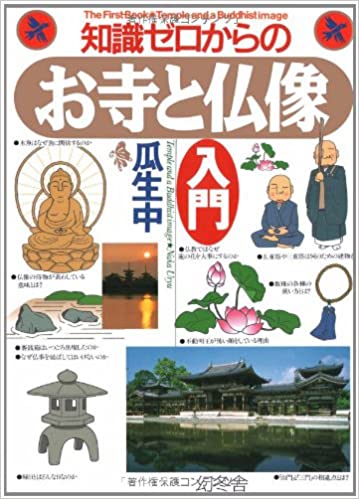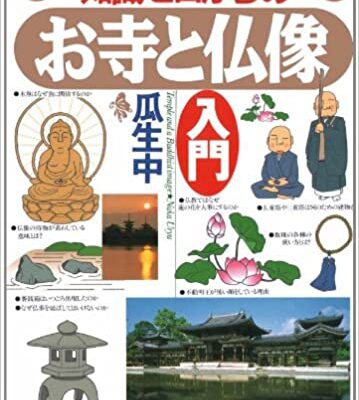瓜生中 著 「知識ゼロからのお寺と仏像入門」 幻冬舎
自分の宗派ぐらいは知っていても、それ以上のことはさっぱり知らない方も多いのではないでしょうか。私もその一人で、実家に仏壇はありますが、お坊さんに会うことはほとんどありません。そこで、最初に買い求めたのが本書でした。
中学校ぐらいで習う、エンタシスの柱について記載がありました。ギリシャの神殿の柱は、中央がゆるやかに膨らんでいることを皆さん学習したと思います。これに対して、日本の柱のエンタシスは、実は、下から三分の一ぐらいのところが一番太いそうです。「目の高さほどのところを太くすることで、柱の安定感を強調」しています。確かに、法隆寺の柱を実際に見ると、膨らがかなり誇張されていて、どっしりした感じがします。時代が下がるにつれ、膨らみはしだいに小さくり、平安時代になるとエンタシスは姿を消し、円筒型の柱が多くなっていきました。
よく、お寺の門を「山門」あるいは「三門」と呼びますが、混乱していないでしょうか。この本の解説によると、禅宗寺院などでは「山門」の字を使わず、「三門」と書く場合もあるということです
「これは三解脱門の略で、迷いから解放されるための三つの道を門にたとえたもの」だそうです。三つの道とは空・無相・無願で、どれも物事にとらわれないことを意味します。ちなみに、3つの入り口の内、どれが3つの解脱の道を表すかは決まっていないので、三門をくぐるときは、迷わず真ん中の入り口を通ればよいとのことです。
他にも、禅宗がもたらした寺院建築様式や木魚の由来など、いろいろな知識が得られますので、入門書として活用されてはいかがでしょうか。(完)

価格:1,430円
(2021/5/7 16:23時点)
感想(4件)
“Introduction to Temples and Buddhist Statues from Zero Knowledge” by Uryu Naka, Gentosha
There are probably many people who know at least about their own religious sect, but have no idea about anything beyond that. I am one of them. I have a Buddhist altar in my parents’ house, but I rarely see monks. So the first book I bought was this one.
It described the columns of entasis, which I learned about in about junior high school. I think everyone has learned that the pillars of Greek temples are gently bulging in the center. In contrast, the enthesis of Japanese columns is actually thickest in the bottom third of the column. The thickest part of the column is at eye level, which emphasizes the stability of the column. Indeed, when you actually see the pillars of Horyu-ji, the bulges are quite exaggerated, giving the pillars a sturdy appearance. As time went by, the bulges gradually became smaller, and by the Heian period (794-1185), entasis disappeared and cylindrical pillars became more common.
We often refer to the gates of temples as “san (Mountain) mon” or “san (Three) mon,” but is this not confusing? According to the commentary in this book, some Zen temples do not use the character “san (Mountain) mon” but instead write “san (Three) mon” (three gates).
According to the book’s explanation, “Sanmon” is an abbreviation for “three liberation gates,” and refers to the three paths to be taken in order to be liberated from delusion. The three paths are emptiness, no-phase, and no-wish, all of which mean not to be bound by things. Incidentally, it has not been decided which of the three entrances represents the three paths to liberation, so when passing through the three gates, one should pass through the middle entrance without hesitation.
You can also learn various other things such as the architectural style of temples brought by Zen Buddhism and the origin of wooden fish, so why not make use of this book as an introduction to Zen Buddhism? (End)
“Introduction aux temples et aux statues bouddhistes à partir de la connaissance zéro” par Uryu Naka, Gentosha
Il y a probablement beaucoup de gens qui connaissent au moins leur propre secte religieuse, mais qui n’ont aucune idée de ce qui se passe au-delà. Je suis l’un d’entre eux. J’ai un autel bouddhiste dans la maison de mes parents, mais je vois rarement des moines. Le premier livre que j’ai acheté était donc celui-ci.
Il décrivait les colonnes d’entasis, que j’ai appris à peu près au collège. Je pense que tout le monde a appris que les piliers des temples grecs sont légèrement bombés au centre. En revanche, l’enthèse des colonnes japonaises est en fait plus épaisse dans le tiers inférieur de la colonne. La partie la plus épaisse de la colonne se trouve au niveau des yeux, ce qui souligne la stabilité de la colonne. En effet, lorsque vous voyez les piliers du Horyu-ji, les renflements sont assez exagérés, ce qui donne aux piliers une apparence robuste. Au fil du temps, les renflements ont progressivement diminué, et à l’époque Heian (794-1185), les entasis ont disparu et les piliers cylindriques sont devenus plus courants.
Nous faisons souvent référence aux portes des temples en tant que “san (montagne) mon” ou “san (trois) mon”, mais cela ne prête-t-il pas à confusion ? Selon le commentaire de ce livre, certains temples zen n’utilisent pas le caractère “san (Montagne) mon” mais écrivent plutôt “san (Trois) mon” (trois portes).
Selon l’explication du livre, “Sanmon” est une abréviation de “trois portes de libération” et fait référence aux trois voies à emprunter pour se libérer de l’illusion. Ces trois voies sont la vacuité, l’absence de phase et l’absence de souhait, qui signifient toutes ne pas être lié par les choses. Par ailleurs, il n’a pas été décidé laquelle des trois entrées représente les trois voies de la libération, aussi, lorsque l’on franchit les trois portes, il faut passer sans hésiter par l’entrée du milieu.
Vous pouvez également apprendre d’autres choses comme le style architectural des temples apportés par le bouddhisme zen et l’origine des poissons en bois, alors pourquoi ne pas utiliser ce livre comme une introduction au bouddhisme zen ? (Fin)
